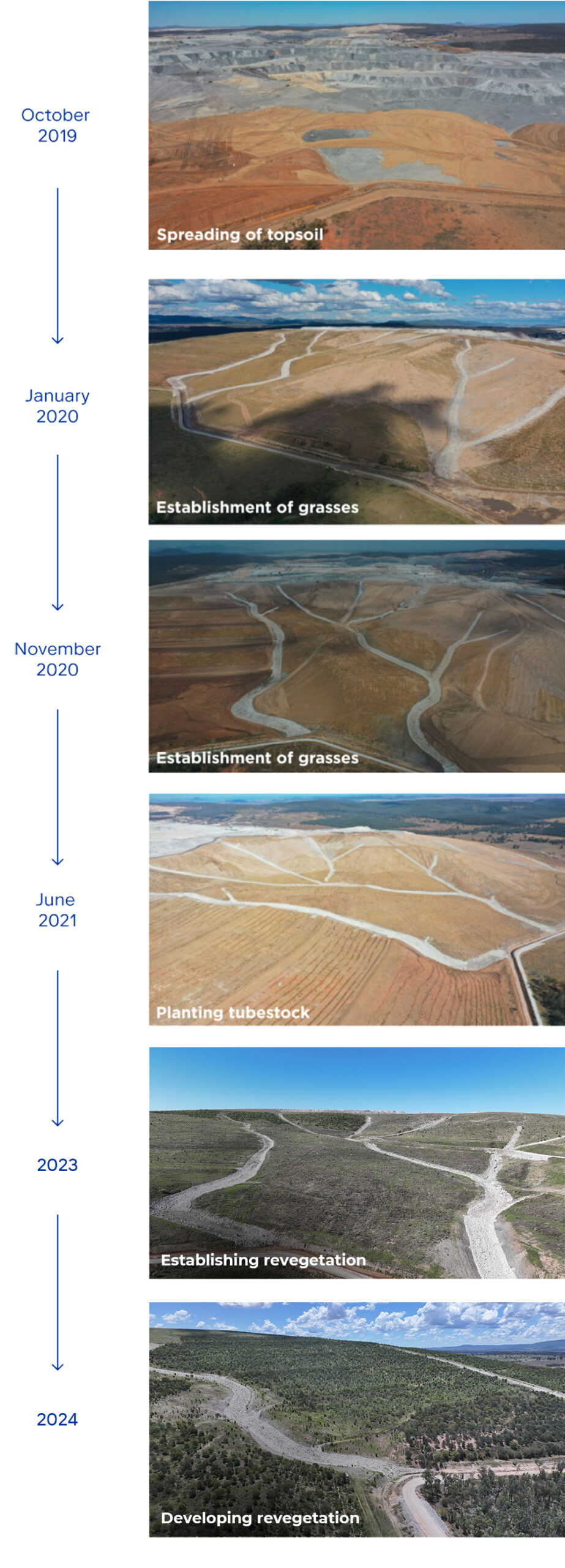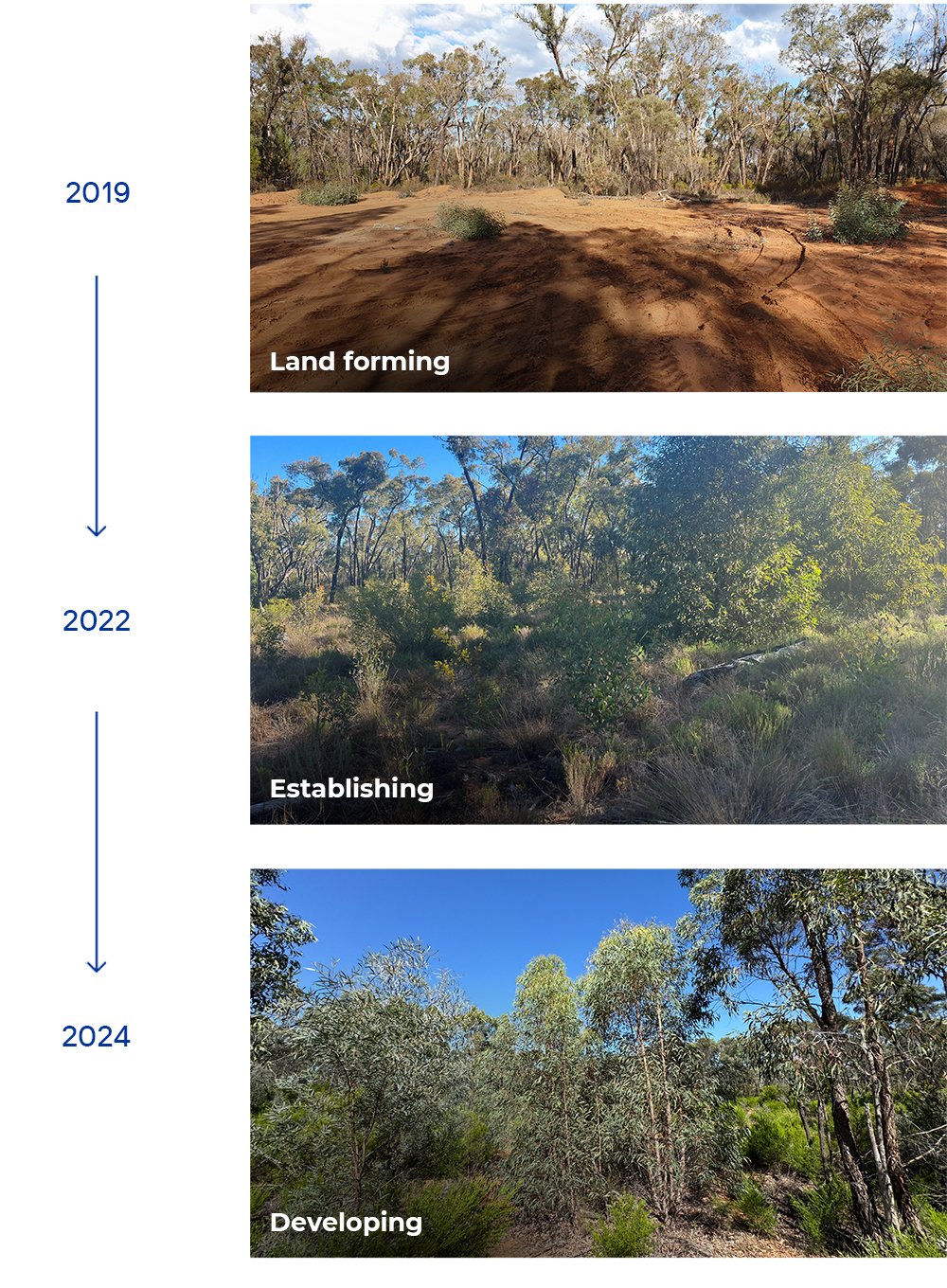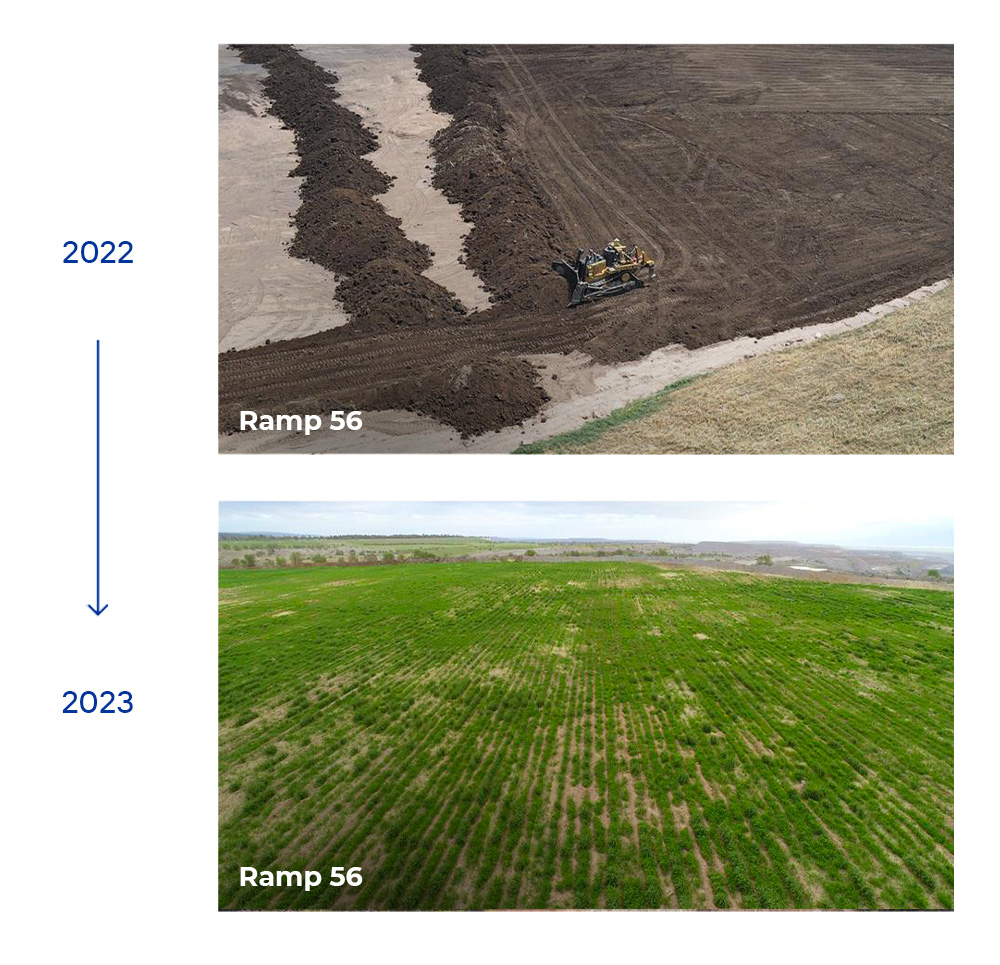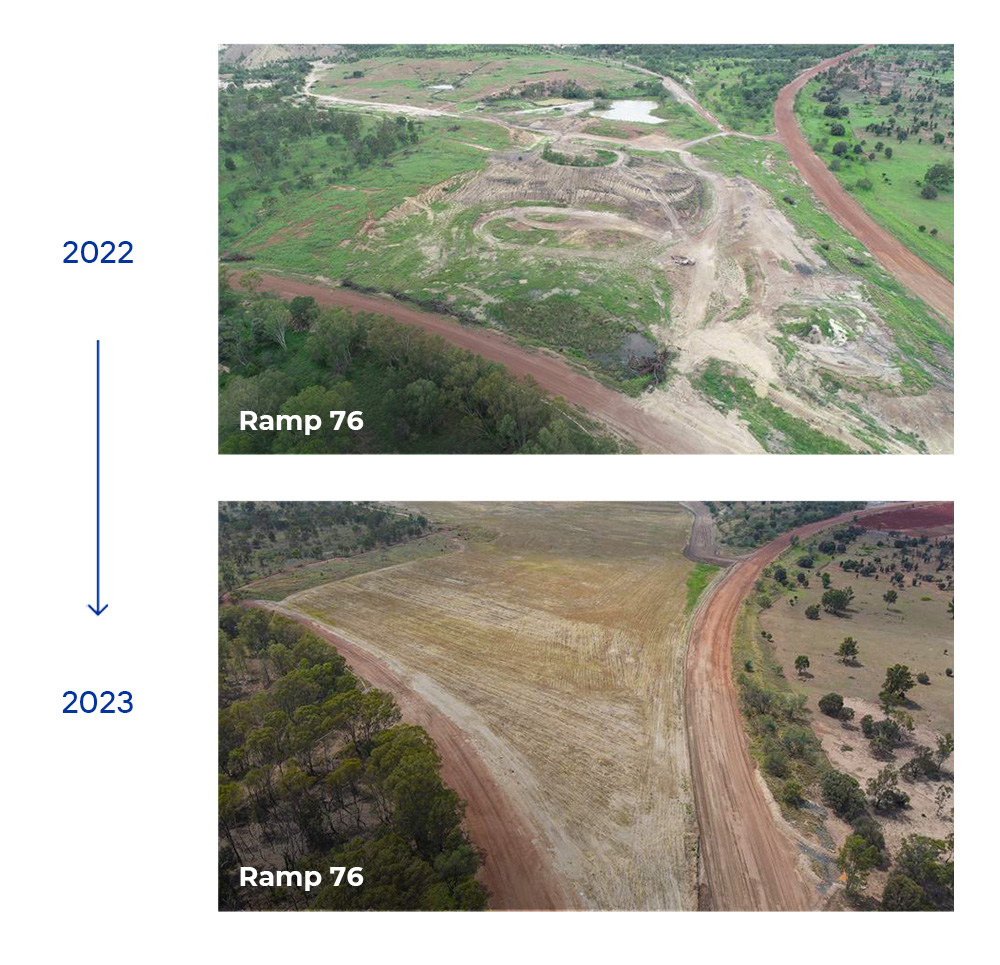Our rehabilitation goals
- Progressively rehabilitate areas, including establishing landforms, during mining.
- Use modern techniques to make sure final landforms are safe, stable and self-sustaining, so that they can be used for more than mining in the future.
- Restore ecosystem functions, including rehabilitating flora ecosystems.
- Undertake rehabilitation that reflects the surrounding landscape, or improves on it.
- Establish landforms that incorporate micro-relief patterns consistent with the surrounding topography.
- Minimise the visual impact of final landforms as much as possible.
Rehabilitation at Maules Creek will result in the development of more than 1,000 ha of woodland forest. To date, approximately
322 ha of progressively rehabilitated land has commenced within the ecosystem establishment phase.
Rehabilitation at Maules Creek is based on a geomorphic landform design which aims to mimic the shape and function of natural landscape features. This approach supports greater long-term erosional stability, improves establishment of self-sustaining ecosystems and requires less long-term care-and-maintenance.
The proposed post-mining land use includes a mixture of native vegetation communities including grassy woodland, shrubby woodland/open forest, riparian forest, native forest and woodland.
Rehabilitating woodland habitats
To date, over 100,000 trees have been planted as part of progressive rehabilitation at Maules Creek.
Narrabri’s post-mining land use will include a combination of native woodland vegetation, biodiversity offset areas, agriculture and water management areas. Since 2008, approximately 193 ha has been progressively rehabilitated towards these uses.
Rehabilitation is conducted as soon as reasonably practicable, as areas become available following longwall mining operations. Rehabilitation practices include (but are not limited to) sealing boreholes utilised for gas drainage and exploration purposes, and repair of surface subsidence impacts.
Demonstrating effective rehabilitation
In December 2024 Narrabri received its first approval of successful achievement of rehabilitation against completion criteria (from the Resources Regulator). This was for an area of surface disturbance associated with exploration programs, rehabilitated in 2019 – 2020
Progressive rehabilitation has been underway at Tarrawonga since seeding first occurred in 2007. By December 2024, approximately 230 ha of woodland habitat has been rehabilitated.
Rehabilitation at Tarrawonga is currently aimed at woodland/forest habitat. Tarrawonga adopted a geomorphic rehabilitation design from 2023 allowing better drainage, less long-term maintenance and a more natural post-mining landscape appearance. It also supports successful restoration of native forest and woodland including the critically endangered White Box—Yellow Box— Blakely’s Red Gum Grassy Woodland and Derived Native Grassland ecological community.
As the mine rehabilitation progresses, agricultural land capable of supporting pasture for cattle grazing will begin to be incorporated, with the target of 257 ha by closure.
Continual rehabilitation improvement
Tarrawonga adopted a hybrid rehabilitation method to transition to the currently used geomorphic design method, which resulted in a blend of traditional contours and geomorphic design.
Mining activities at Werris Creek ceased in June 2024. The site is currently undergoing final rehabilitation.
The mine’s rehabilitation is aimed at establishing a mix of native woodland habitats and agricultural (grazing) land. As the site is flanked to the east and west by biodiversity offset areas, rehabilitation is targetted at optimising the potential for creation of a wildlife corridor between the adjacent remnant native vegetation.
Rehabilitation at Werris Creek incorporates standing “stag” trees recycled from the clearing process. This provides instant habitat (and ecosystem enhancement) for native birds, bats and marsupials, as well as a variety of ground-dwelling species including reptiles and insects.
Construction and initial operations of the Vickery Open Cut commenced in 2024. As mining progresses, the site will be progressively rehabilitated in accordance with the Forward Work Program and Rehabilitation Management Plan.
Vickery’s rehabilitated landform will integrate with surrounding natural landforms to the greatest extent possible. Approved post-mining land uses include native ecosystems, agriculture (grazing), water storage and a final void.
Blackwater has progressively advanced over 3,400 ha of existing rehabilitation towards achieving its nominated post-mining land uses of cattle grazing and woodland habitat.
Blackwater’s extensive mine life has resulted in rehabilitation practices changing over time. Initially, areas of rehabilitation were constructed by regrading dragline spoil rows to undulating plains and rises. Draglines were then replaced by dozers, resulting in longer, more uniform slopes that mimic natural drainage lines and aim to minimise erosion. With a historic focus on establishing pasture-based grazing systems, post-mining land use targets now include a suite of pasture land and woodland habitat.
Progressive rehabilitation is underway at Daunia.
Rehabilitation is maximised by scheduling rehabilitation as soon as practicable after land becomes available. Rehabilitated areas are seeded to achieve a mix of cattle grazing and woodland habitat post-mining land uses.
Mining activities at Sunnyside ceased in 2019. Much of the site is already demonstrating achievement of successful ecosystem establishment (55 ha of pasture land, and 35 ha of woodland habitat).
Remaining rehabilitation at the site involves removal of the sediment dams as they are no longer needed for rehabilitation maintenance. The rest of the site is in an active state of monitoring and care-and-maintenance (landform maintenance, and pest management).
Coal mining at Rocglen started in 2008 and concluded mid-2019. Final rehabilitation works were undertaken between 2019 and 2023. The site is currently under monitoring and maintenance.
The former mine has been rehabilitated into establishing woodland vegetation, blending into the surrounding Vickery State Forest. It includes portions of pasture for potential grazing.
Whitehaven will continue to monitor and maintain the rehabilitated land until it can be demonstrated that the site is safe and stable, with established self-sustaining ecosystems as per defined rehabilitation criteria.
Mining activities at Melville – part of the original Black Jack Colliery, ceased in 1989. In 2005 Whitehaven acquired the mining lease for the area as part of purchase of Namoi Mining, and took on responsibility for rehabilitation of the disused site. Approximately 3.5 ha required rehabilitation within a larger 408 ha area of legacy mining area.
The site is at the base of the prominent Black Jack Hill and is highly visible from nearby roads and residences. Whitehaven has worked with neighbouring landholders to ensure the area would have a final landform and use suitable to the local context – grazing land integrated with the surrounding farm land and Black Jack Hill.
The site is currently under monitoring and care-and-maintenance, with grazing recommenced in 2023.
cumulatively
cumulatively
cumulatively
cumulatively
cumulatively
Mine rehabilitation in NSW
The NSW Resources Regulator is responsible for making sure that land disturbed by exploration and mining activities is returned to a safe, stable and sustainable state. They monitor rehabilitation activity and have a range of tools to support timely rehabilitation and in accordance with approved commitments.
If a mining project is approved in NSW, the required rehabilitation outcomes are incorporated into the conditions of the development consent. A rehabilitation security bond also needs to be provided before exploration and mining activities begin, so that the government has enough funds held aside if a company defaults on its rehabilitation obligations.
Find out more at resourcesregulator.nsw.gov.au/rehabilitation

 Whitehaven coal
Whitehaven coal



